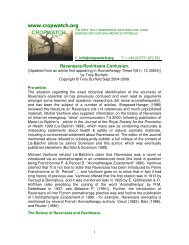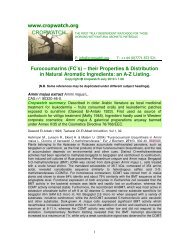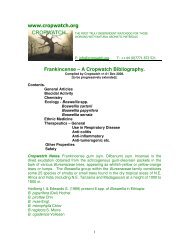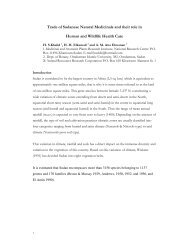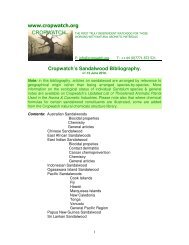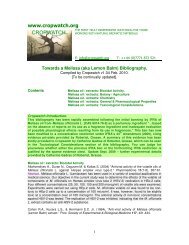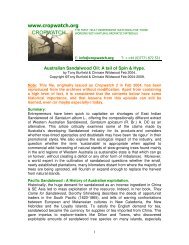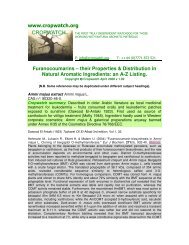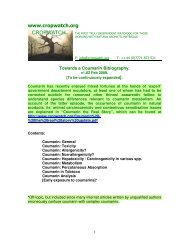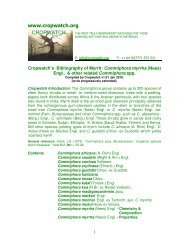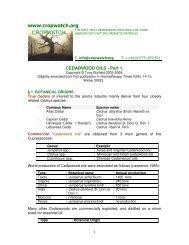The Adulteration Of Essential Oils - Cropwatch
The Adulteration Of Essential Oils - Cropwatch
The Adulteration Of Essential Oils - Cropwatch
You also want an ePaper? Increase the reach of your titles
YUMPU automatically turns print PDFs into web optimized ePapers that Google loves.
identical aroma chemicals, to the product, except for some solvent-like<br />
diluents. This category would include the following oils:<br />
Sweet orange oil (Citrus sinensis)<br />
Clove leaf oil & stem oils (Syzygium aromaticum)<br />
Citronella oil (Cymbopogon spp.): (although the oil has been known to have been<br />
crudely adulterated with dipentine and citronella terpenes)<br />
Camphor oil white (Cinnamomum camphora fractions)<br />
Cornmint oil (Mentha arvensis subspp).<br />
Eucalyptus globulus oil<br />
Tea tree oil (Melaleuca altenaria) (although through the economies of larger scale,<br />
it may be profitable to add terpinen-4-ol and α- & γ-terpinenes; up until recently they<br />
have been been as expensive as the essential oil).<br />
Other oils may be difficult to reconstitute with anything other than diluents<br />
because the major components are not commercially available; as is the case<br />
with patchouli oil & vetiver oils. .<br />
4. <strong>The</strong> addition of isolates or natural components to essential oils e.g.<br />
the addition of pure natural eucalyptol ex E. globulus oil (Eucalyptus globulus)<br />
to rosemary oil (Rosmarinus officinalis) or rectified ho oil (>99.5% (-)-linalol) to<br />
lavender and bergamot.<br />
5. <strong>The</strong> addition of bases or reconstituted essential oils to genuine oils &<br />
absolutes. It is particularly economically attractive to extend high value floral<br />
absolutes such as rose (Rosa spp.), jasmin (Jasminum grandiflora other spp.)<br />
and osmanthus (Osmanthus fragrans var. auranticus), and the more valuable<br />
oils such as neroli oil and rose otto, and this practice occurs extensively within<br />
the trade.<br />
6. <strong>The</strong> addition of individual unnatural components to oils and aromatic<br />
raw materials.<br />
Absolutes have been traditionally produced for the consumption of the<br />
perfumery industry, but are being increasingly employed in aromatherapy (in<br />
spite of using un-natural solvents in their manufacture). Revelations that<br />
materials such as Linden Blossom absolute (Tilia spp.) contain<br />
hydroxycitronellal, or that Gardenia absolute (Gardenia spp.) has added<br />
styrallyl acetate, or that added Schiff’s bases have been found in floral<br />
absolutes, should not therefore come as a complete surprise. It has been<br />
suggested that if the synthetic fragrance compound is added in to the<br />
aromatic plant material during manufacture, the added material will “blend in”<br />
better. In other instances, absolutes may well contain perfume bases or<br />
reconstitutions, rather than a single key character compound.<br />
7. <strong>The</strong> addition of ”normal” oils to oils certified as “organic”.<br />
Many certifying bodies (EcoCert, Soil Association) seemingly rely on<br />
inspection regimes, batch tracking and the separate & secure storage of<br />
organic oils, rather than independently analysing finished oils for pesticide<br />
levels, a situation inviting abuse by unscrupulous traders. <strong>The</strong>re is also the<br />
huge question of “who inspects the inspectors”, the lack of external expert<br />
input into their protocols, and the denial of free public access to the records of<br />
these bodies – but these topics (and many others) are another issue! <strong>The</strong><br />
8





